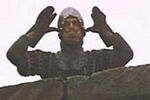Mason-Dixon Line
The Mason-Dixon Line was a historic, heavily fortified system of artillery emplacements, trenches, and checkpoints built by the South in the years just prior to the American Civil War to deter an invasion from the Yankees — a veritable Great Wall of Pewter.
The Mason-Dixon Line is not to be confused with the Manson-Nixon Line between Northern Androgyny and Southern Supremacy, which still exists today.
Location and construction

The Mason-Dixon Line started on the coast of Maryland and wound its way inland, all the way through Missouri. Although the line was built for the most part on the border of the USA and the Confederacy, territory in the border states was often in doubt, and the Line went right down the middle of some of it.
Building the Line took virtually all the concrete the young nation produced, a chunk of iron the size of Atlantic City, four hundred bricks, and the entire Alabama forest. More than seventy-five million nails were used, of which at least 3400 were thumbnails from carpenters who whacked their thumbs accidentally with their hammers.
So important did the Line become to the defense of the Confederacy that the entire country took its nickname, Dixie, from it. It did so to spite the North, and only after Josiah Benjamin publicly decreed that the North would not go with Masie, which sounded like some pansy, non-slaveholding country.
Tactics along the line
In the early days of the war, the Union Army found to its dismay that the Mason-Dixon Line could not be breached. Artillery barrages from the tops of the walls devastated the Northern forces, and General Ulysses S. Grant began drinking heavily and occasionally even offering President Lincoln "a pop". The war soon degenerated into a stalemate, during which Northern troops under Grant's command tried in vain to find a weak spot in the Line.
The defeat of the line
Eventually Grant, though still on the Sauce, noticed that the Mason-Dixon Line extended only to the Missouri border. Congress in 1864 declared that Kansas would be a Free State. This was merely a ruse, but all the slaveholders in Kansas fell for it. When they vacated their Kansas plantations, the Union Army was suddenly able to go around the end of the Line, turning the tide of battle and securing victory for the North.
See also
| Featured version: 31 December 2020 | |
| This article has been featured on the main page. — You can vote for or nominate your favourite articles at Uncyclopedia:VFH. | |


